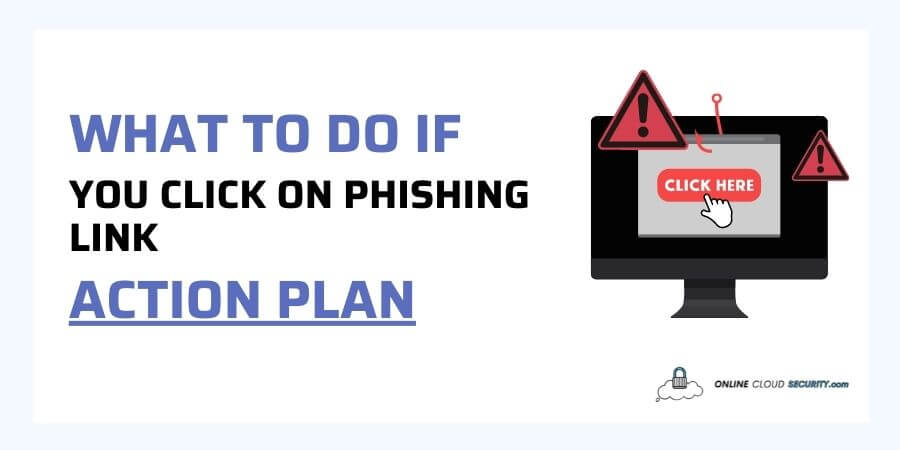
Dave Miller – Tech Enthusiast & Security Expert – May 10th, 2022

Phishing scams are pretty common these days, and many people worry about what to do if clicked on phishing link.
Over the previous several years, social engineering assaults have become one of the most common and deadly kinds of cybercrime. Phishing is a systematic way of compromising accounts and getting access to sensitive information.
It may get done on a variety of days. If you’ve already got duped into clicking a dangerous link, you’ll need to learn how to avoid negative consequences.
Continue reading the article to learn how phishing works and how to deal with it if you believe your personal information is at risk of being stolen.
Because phishing is one of the most common forms of social engineering assault nowadays. It relies on user gullibility and inexperience. Most of the time, phishing scams mean sending misleading emails or texts. They seem to be from trustworthy sources and duping the victim into opening a link attached. A malicious link can lead to malware installation or someone taking down all the information you write with good intent. Such scams target many business personnel and personal emails every day, with terrible consequences for the victims. Phishing attacks get classified into two categories.
Whatever phishing assault you were involved in, you must know how to reduce the consequences by understanding what to do if clicked on phishing link whether on PC, iOS, or Android.
Fact: Apple iOS is a closed ecosystem. Although Apple does not offer its source code to app developers, Android devices do. As a result, Android may be hacked simply by clicking on a link or downloading an app from an unknown source.
There is no question that phishing assaults may get directed at any device, including your PC, iOS, or Android smartphone. What you must do next is the same regardless of your platform. So, if you make the error and wonder what to do if clicked on phishing link, take these precautions to limit the damage.
Fact: If you’re in a business environment, call your IT staff right away rather than attempting to mitigate the situation yourself.
If you click on a phishing link, you should first shut off your device’s source of communication with the hacker by unplugging it from the internet. Mainly the Phishing link was intended to get the following things from the victim.
Turning off the internet on your laptop with Windows, iOS, or Android devices is simply turning off the WI-Fi. Unplug the cord if you are utilizing a Lan connection right away. It will prohibit the virus from transmitting confidential material or downloading malicious software, preventing someone from directly accessing your device. You can see some of the examples of phishing links from the link below
Bonus Info: CheckPhish uses Machine learning techniques on Real-Time URLs through Website Sandboxing. Instead of accessing a suspicious link, this website allows you to examine whether it is related to phishing or not.
After you’ve unplugged your device from the internet, you’ll need to back up your data. Although this step has nothing to do with phishing, it should be part of your daily routine. A solid backup program will keep all your information safe and secure in a computer accident or damage. Below are some outstanding backup software options.
These programs are helpful in everyday life. However, suppose you don’t back up your data often. In that case, data might be lost or overwritten when rebounding from a phishing assault. Moreover, online backup is useless since you don’t have an internet connection. It is why you should now back up your files offline. It may get done in various ways using a hard drive, USB, or some of the below methods
You should already have a malware scanner installed on your computer to prevent any malicious downloads. Windows Defender effectively identifies malware files, prevents exploits and network-based assaults, and warns phishing sites for Windows users. However, other solutions provide more robust protection against these risks.
Because you cannot install any additional software after disconnecting the internet, the Windows Defender scanner may be of assistance. But, if you want to take it a step further. In that case, you may download a Malware scanner on a different computer and then utilize it on the device where you accidentally clicked the phishing link.
Below are some of the most excellent tools for preventing phishing attacks.
There are no universally accepted criteria for how frequently you should update your passwords. According to some IT professionals, users should change their passwords every three months. If you suspect you’ve been a target of a cyber-attack, you should change your password right away.
If you suspect you’ve got duped into responding to a phishing mail, update your internet credentials with a strong password. Make use of a password manager as a priority to prevent memorizing or taking notes on your passwords. Additionally, try using two-factor authentication while updating your password. It will provide an additional security layer for online accounts beyond a username and password.
Fact: Almost two-thirds of people have several accounts with the same password. Please do not make this mistake since a single data leak might cost you everything.
If you believe you have got scammed or clicked on the malicious link, the best action is to contact the appropriate security authorities for advice
Bonus Tip for iOS Users: If you get a strange email or text message that seems to be from Apple, please forward it to reportphishing@apple.com.
The most straightforward approach to avoiding being a victim of phishing links is to be aware of them. Several online awareness programs instruct a variety of cyber risks, including phishing and other social engineering assaults.
These courses will teach you how to recognize online security dangers that might cause problems to you and how to take action to reduce your risk. Phishing, social engineering, hacked passwords, and inadequate network security may expose your company to attackers, primarily due to remote workers. If you’re a business owner, cybersecurity awareness training is the most effective approach to teach your staff how to strengthen the human part of your company’s security.
Although it is challenging to eliminate social engineering attacks, security awareness, education, and monitoring may help people and organizations protect themselves.
Social engineering refers to malicious behaviors, including phishing, baiting, tailgating, and vishing. It gets carried out through human interactions and psychological manipulation to deceive users into committing security blunders. Scammers may easily fool and manipulate users because these scams get tailored around how individuals think and act. It will result in your data loss, which might have catastrophic repercussions.
Fact: Social engineering gets used by cybercriminals in 98 % of attacks.
Here are some of the surprising stats of social engineering related to phishing
The above stats seem like surprising large numbers related to phishing. Hackers are mainly using phishing as a method of attack. You should be able to educate yourself on the subject to keep your information as safe as possible by the tips presented in this article.
Phishing attempts have become a severe but inescapable danger in the digital era. Companies have been working around the clock to deal with the risks of phishing assaults, which are the most common nowadays and cost them millions of dollars.
The Anti-Phishing Working Group is one of those organizations that provides several tools, including phishing education, that businesses may utilize in conjunction with their anti-phishing initiatives. They have several materials available that you may use.
Nonetheless, the phishing assault is not going away anytime soon. The best thing you can do is take precautions before falling into the trap. I’ve included a few easy-to-remember suggestions for what to do if clicked on phishing link before and after. These solutions may be costly in terms of security.
Still, it is preferable to have them now than to lose everything later due to scammers. You’re OK to go if you think you can keep yourself from clicking strange links. Remember that you may always use the sandboxing techniques of various free websites to verify a suspicious link.
**Onlinecloudsecurity.com is a participant in the Amazon Services LLC Associates Program, an affiliate advertising program designed to provide a way for websites to earn advertising revenues by advertising and linking to Amazon.com and affiliated sites. As an Amazon Associate we earn affiliate commissions from qualifying purchases.**

Dave Miller is an IT Consultant for Online Cloud Security and has over 7 years of experience in the Information Technology space. He also specializes in repairing laptops & computers. In his spare time, he loves to talk about new technologies and hosts monthly IT and Cyber Security meetings in the Houston area.
Click any button down below to share this article on the following channels:

Online Cloud Security is here to recommend you the most secure devices, from laptops to smartphones, we only want to provide you with products that we have tested and used ourselves for online security. Every product that we recommend is heavily inspected and tested for security against hackers, viruses, malware, and any other intruders that may want to steal your information.

Online Cloud Security is here to recommend you the most secure devices, from laptops to smartphones, we only want to provide you with products that we have tested and used ourselves for online security. Every product that we recommend is heavily inspected and tested for security against hackers, viruses, malware, and any other intruders that may want to steal your information.
Your Trusted Source for Online Security